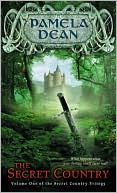First Book Friday: Pamela Dean
Welcome to First Book Friday.
Pamela Dean (LJ, Facebook) has no idea what I’m going to write here. I could talk about how she and I followed some of the same advice about having to write short fiction before you can do novels — advice that isn’t actually true, as it turns out. Or I could talk about the first time a friend thrust a copy of Tam Lin into my hands saying “You have to read this!” and my fanboyish glee years later when I opened up my e-mail and said, “Holy crap, Pamela Dean read my blog!”
Ahem. Anyway, read on, and enjoy the tale of Pamela Dean’s first published novels.
#
My first novel was only half a book. I started it when I was fifteen. I had been writing on and off since I was eight, but mostly poetry. As I became more interested in fantasy and science fiction, I started trying to write short stories, since such common wisdom as I could garner in those pre-internet days stated that one always began with short stories and went on to novels.
In fact, I could not begin if I had to begin with short stories. Even my sonnets were always overflowing their bounds and becoming entire narrative poems with sonnets as the individual verses. I was rescued from my dilemma by a friend who had been given the Ballantine paperback edition of Tolkien’s The Lord of the Rings. She was suspicious of such a long, weird-looking book; and, knowing that I read such things, asked me to just check it out for her. It hit me like a tornado; I was never the same again.
One of its many effects was that I junked the short stories and began writing a huge fantasy epic – planned for three volumes, naturally – with a female protagonist. At some point I realized that having read one epic fantasy novel at the age of fifteen did not actually equip one to write an epic fantasy novel. What had I actually read a lot of? Children’s fantasy novels. I started over with a cast of five cousins unnervingly like the Pevensies in the Narnia books. The characters who were not like the Pevensies were a lot like the crew of the original “Star Trek.” Fortunately for me, I couldn’t manage a viewpoint character like any of Lewis’s, and devolved upon one named for Laura Ingalls in the Little House books, although she is a lot more like me at her age than like Laura Ingalls.
I stopped working on the book when I went off to college, but what I learned while not writing had profound effects on the finished book. After I fled graduate school, I revised my teenaged efforts extensively and then plodded on and on, through two writing group, and finally finished a work called The Hedge and the Sword. It was shorter than Lord of the Rings, but still very long. The writing groups were essential, particularly the second one, the Scribblies. I would probably still be writing those books today if I had been all on my own.
By the time my book was done, Pat Wrede, a member of the Scribblies, had sold her first novel and found an agent. The agent kindly agreed to look at my book. However, she was perplexed by the intractable length and the apparent impossibility of cutting the book anywhere, and felt that she could not market it properly. I wasn’t experienced enough to be daunted, and neither were my fellow Scribblies. At their behest, I reread the manuscript and picked a spot, two-thirds of the way through, where the action paused 
Terri bought the book despite its unfinished character and demanded to see the rest of it, which she also bought. The two volumes were retitled The Secret Country [Amazon | B&N | Mysterious Galaxy] and The Hidden Land [Amazon | B&N | Mysterious Galaxy].
I had hoped that both halves of the original large book would be published in the same year, but the first was published in 1985 and the second in 1986. Moreover, Ace steadfastly refused to indicate anywhere on the first book that it was really only half a story. I still get irate mail about that. I think I picked the right place to divide the book, though. The tone also changes at the place where the action pauses, and I have a lot of mail from people whose absolute favorite of all my books is The Secret Country, stealthy inconclusive ending or no. And when Sharyn November did the reprints for her Firebird line, she put the proper information about the books’ connection on the covers, and brought them out within a few months of one another.






zollmaniac
January 14, 2011 @ 10:24 am
At last! A writer who struggles to write short fiction as much as I do… in that I find it impossible to not turn a short story into a whole book – if not entire series.
Maybe there’s hope for me after all.
Jim C. Hines
January 14, 2011 @ 11:05 am
When I was editing Heroes in Training, I approached a fairly well-known and successful fantasy novelist and asked if he’d be interested in contributing a story. He looked at me and said, “I can’t write short stories for shit.”
I think there’s hope for you 😉
KatG
January 16, 2011 @ 7:30 pm
Pamela Dean put her start-up story on your blog!
Okay, I’m better now.